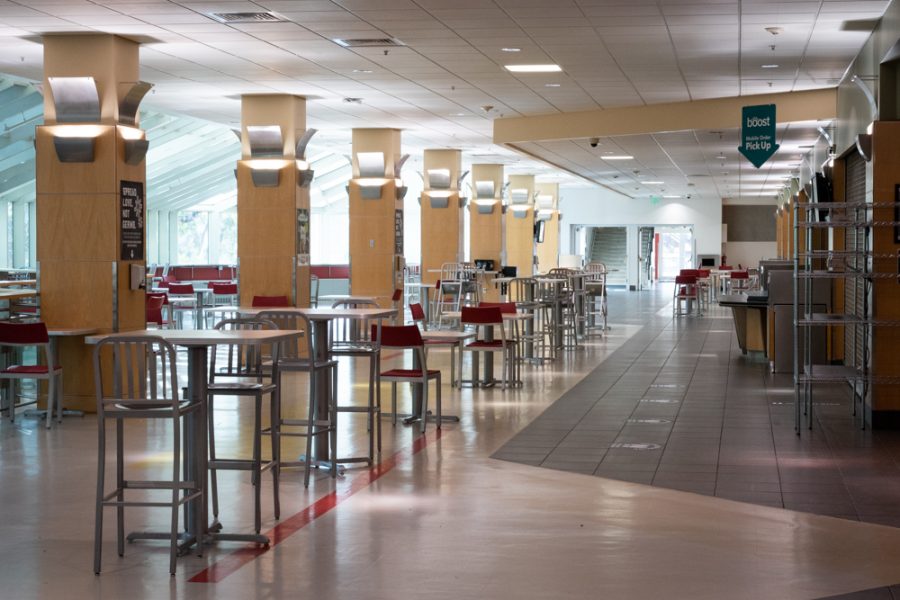Barron: Time for the U to Close Campus
The A. Ray Olpin Union’s food court sits empty on September 21st 2020. (Photo by Jack Gambassi | The Daily Utah Chronicle)
October 27, 2020
Gov. Gary Herbert announced preemptive health measures on March 12 to prevent community spread of COVID-19 in Utah. Following Herbert’s announcement, the University of Utah shifted from in-person instruction to remote learning to protect students, faculty and staff from the virus. Fast forward seven months, Utah is now experiencing one of the worst COVID-19 outbreaks in the country. When the U invited students back to campus for the fall semester, the administration promised to rely on recommendations of public health experts and metrics like case count and hospital capacity to inform university operations. Strangely, even as cases are rising and ICUs are filling up, the U has not announced any major changes to campus. To address this rise and protect our community, the U must close campus and shift to entirely remote instruction for the remainder of the fall semester.
Herbert announced a mask mandate and gathering restrictions for six counties, including Salt Lake, in response to rising case numbers. Sadly, these new restrictions are not enough to curtail infections. According to the Harvard-led COVID Suppression Guidance, stay-at-home orders are necessary to prevent the spread of COVID-19 in Salt Lake County. While stay-at-home orders have not been announced, our university’s administration should not wait for the state to take action. The U must close campus immediately, move all classes online and ask instructors to adjust course requirements to ensure students can complete their classes remotely. Students should also be released from their on-campus housing contracts, but dorms should remain open for students unable to leave.
Early in the pandemic, public health officials asked people to stay home to “flatten the curve” in an effort to prevent healthcare systems from being overwhelmed with COVID-19 patients. With over a thousand new cases every day, Utah has failed to flatten the current curve. Unsurprisingly, as of October 16, Utah’s ICUs were 75% occupied. The ICU at the University of Utah Hospital is currently operating overcapacity. Extra beds have been set up and doctors and nurses are working overtime to provide care to patients. This strain on our healthcare system is a public health crisis that puts all Utahns at risk. Herriman resident Laurie Pratt Terry was near death after a heart attack but had to wait two and a half hours for a bed in the ICU. As a renowned medical school and the stewards of one of the state’s largest hospitals, it is unbelievable that the U has not closed campus to reduce unnecessary exposures and lighten the load on our healthcare system.
If campus closes, some worry that students may use remote learning as an opportunity to travel and may continue spreading the virus. This concern is understandable — risky behavior from college students has become a hallmark of the pandemic, however, some developmental psychologists believe this fact is indicative of mixed messaging from authorities and not necessarily of inherent selfishness. Choosing to keep campus open just to prevent some students from engaging in reckless behavior is irresponsible and puts every student at risk. Administrators should couple campus closure with an announcement clearly explaining why this action was necessary for the health of our community.
In March, the U took unprecedented action to protect our community from COVID-19 — moving more than 32,000 students to fully remote learning in less than a week. The transition from in-person classes to online learning was not seamless, but this shift undoubtedly saved lives. Despite their previous success, the U is now failing to take decisive action despite the ongoing spike in cases and ICU patients. Personally, I do not understand why. Little has changed since March except for COVID-19’s prevalence in Utah. Continuing to keep campus open will only further endanger students, faculty and staff.









Kenneth • Dec 1, 2020 at 2:58 am
99% of the U’s student body have a 99.98% chance of surviving the coronavirus. But let’s cancel classes just like that? In your opinion, is there ANYTHING that is worse than the terrifying coronavirus “case counts” we’ve all been hearing about nonstop all year? Perhaps huge jumps in suicide is worse? Maybe child abuse? Possibly mental illness? No?
Hannah • Oct 31, 2020 at 1:10 am
This has been my first semester of college, and I have noticed a real stubbornness on the part of the university to adjust quickly to the pandemic situation. On a more subordinate level, my classes have a common theme of trying to do things the same way as before but also by simply transplanting them onto an online format. As a result, this has been an intensely frustrating school year, one that has brought unnecessary bitterness into my life due to being unable to communicate well with governing levels in the university and beyond. I couldn’t agree more that the university needs more flexibility in handling classes and college life as well as an increase in timely problem-solving.
Sarah • Oct 29, 2020 at 4:37 pm
I completely agree. It’s shocking to me that this has not been the case.
Danielle • Oct 29, 2020 at 11:35 am
Here here! Thank you for saying this so directly. I am an older student. My life, the lives of my family members and my clients who entrust me with their healing are all at risk because I am required to attend class that can easily be conducted via zoom. Overall, I am impressed with how the University has handled the pandemic, even how they have handled opening up but enough is enough…exposure becomes exponentially more of a risk every day that l attend class. My professor is great about encouraging us to stay home even with the slightest symptoms and my classmates seem to be very respectful. I trust my group, but I have had to miss several classes Inc account of seasonal cold symptoms that I would have been able to attend via zoom, so my “in person” educational experience is actually being hurt by not switching fully to remote healing. What exactly are ww trying to prove?